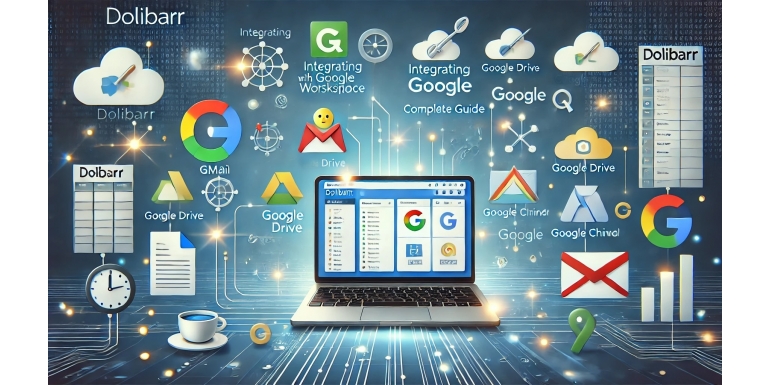
Introduction
Dolibarr is an open-source ERP and CRM solution that enables businesses to efficiently manage their commercial, accounting, and customer relationship operations. However, to further optimize productivity and collaboration, it is often necessary to integrate Dolibarr with other powerful tools such as Google Workspace (formerly G Suite). Google Workspace provides a suite of cloud applications such as Gmail, Google Drive, Google Calendar, Google Sheets, and Google Meet, which can significantly enhance Dolibarr's functionalities.
In this article, we will explore how to integrate Dolibarr with Google Workspace, detailing the various steps, benefits, and tools required for effective synchronization.
1. Why Integrate Dolibarr with Google Workspace?
1.1. Improved Email Management
Integrating Gmail with Dolibarr allows businesses to centralize communications with clients and suppliers directly within the CRM. This facilitates interaction tracking and email archiving.
1.2. Calendar Synchronization
With Google Calendar, events, appointments, and tasks defined in Dolibarr can be automatically synchronized with the company’s agenda, preventing scheduling conflicts.
1.3. Document Storage and Sharing
Google Drive provides a secure storage space to save and share documents related to clients, quotes, and invoices generated by Dolibarr.
1.4. Automation and Collaboration
Using Google Sheets and Google Docs, businesses can collaborate in real time on documents generated from Dolibarr and create dynamic dashboards powered by ERP data.
2. Setting Up Dolibarr - Google Workspace Integration
2.1. Prerequisites
Before starting the integration, ensure you have:
-
An active Google Workspace account with necessary administrative permissions.
-
An up-to-date Dolibarr installation.
-
Required Dolibarr modules enabled (REST API, Emails, Calendar, etc.).
-
Administrator access to your Dolibarr server.
2.2. Connecting Gmail to Dolibarr
-
Access Dolibarr settings:
-
Navigate to Configuration -> Email.
-
Add an SMTP server using Gmail’s settings.
Gmail SMTP Settings:
-
SMTP Server:
smtp.gmail.com -
Port:
587 -
Security: TLS
-
Username: Your Gmail address
-
Password: Generated via Google’s App Passwords
-
-
Test email sending:
-
Send a test email from Dolibarr to verify the connection.
-
2.3. Google Calendar Synchronization
-
Enable the Agenda module in Dolibarr.
-
Navigate to Configuration -> Agenda.
-
Add a new Google connection using Google APIs:
-
Create a project in Google Cloud Console.
-
Enable the Google Calendar API.
-
Generate OAuth 2.0 credentials and add them to Dolibarr.
-
-
Synchronize events and check if Dolibarr’s calendar entries appear in Google Calendar.
2.4. Integration with Google Drive
-
Enable the Google Drive API in Google Cloud Console.
-
Generate OAuth 2.0 access credentials.
-
In Dolibarr, go to Configuration -> GED (Electronic Document Management) and add Google Drive as a remote storage option.
-
Test file upload and retrieval to confirm integration.
3. Automation and Customization of the Integration
3.1. Using Zapier to Connect Dolibarr and Google Workspace
Zapier is a tool that automates interactions between Dolibarr and Google Workspace without requiring coding.
Examples of automations:
-
Automatically add a Gmail contact when a new client is created in Dolibarr.
-
Create a Google Calendar event when a task is added in Dolibarr.
-
Automatically save Dolibarr invoices to Google Drive.
3.2. Creating Custom Reports with Google Sheets
It is possible to export data from Dolibarr to Google Sheets to create real-time dashboards.
-
Enable the CSV Export module in Dolibarr.
-
Export the required data (sales, invoices, contacts, etc.).
-
Use Google Apps Script to automate data import into Google Sheets.
-
Create dynamic charts for efficient visual tracking.
4. Security and Best Practices
4.1. Access and Data Protection
-
Enable two-factor authentication on Google Workspace.
-
Restrict permissions for used APIs with specific access rules.
-
Store OAuth credentials in a secure file on the Dolibarr server.
4.2. User and Role Management
In Dolibarr:
-
Define roles and permissions to limit access to Google Workspace-related features.
-
Monitor user activity to prevent misuse.
4.3. Backup and Recovery
-
Schedule automatic backups for emails, calendars, and documents linked to Dolibarr.
-
Regularly test data restoration to prevent potential loss.
Conclusion
Integrating Dolibarr with Google Workspace significantly enhances productivity and business information management. Whether it’s centralizing emails, synchronizing calendars, storing files, or automating workflows, the possibilities are extensive.
By following this guide, you can effectively connect your Dolibarr ERP with the Google Workspace suite and fully leverage their combined functionalities.
Have you already tested this integration? Share your experience in the comments!
